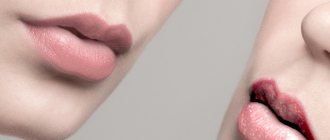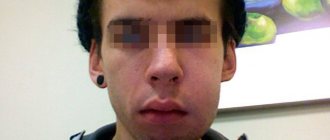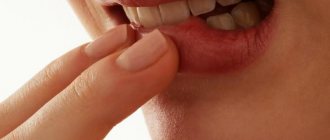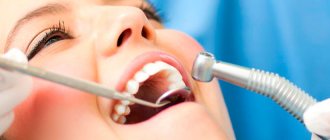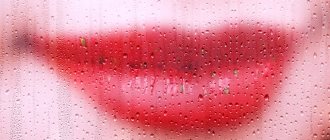Last update: 03/03/2021
Dry lips in a child can turn from a small nuisance into a big problem if care is not taken in time. But it is very easy to ignore this problem - young children may remain silent and not complain, fearing the terrible treatment with pills and injections.
In fact, there are a dozen causes of dry skin. The most common ones seem very simple, but still constantly provoke peeling and cracking of the lips.
How to deal with dry lips in a child?
To care for a child’s lips, only special cosmetics based on natural ingredients, without chemical dyes and fragrances, are suitable. In winter, before going outside, be sure to treat your baby’s lips with a rich hygienic lipstick, which will nourish and protect from the cold, while also lasting long enough.
An alternative to lipstick can be regular baby cream. If you are very dry, you can apply it in a thick layer at night. You can also lubricate your lips with olive or sea buckthorn oil - it leaves a nourishing and protective film on the lips, even if you lick it off.
Balm "La Cree" combines the best of active natural ingredients that soften and heal the skin. This hypoallergenic product can be used for very young children. Active ingredients include: shea butter, almond and castor oils, avocado extract, beeswax, vitamins A and E. This set provides comprehensive care at any time of the year.
Treatment of atopic dermatitis in children
There is no complete treatment for atopic dermatitis, that is, there are no methods of therapy that would lead to complete recovery (change the long-term prognosis of the disease). All existing methods of therapy change only the short-term prognosis - for the coming months.
However, treatment is necessary:
- to improve the quality of life of the child and family; for the prevention of secondary local complications (infections, skin atrophy, etc.);
- for the prevention of psychological problems (sleep disorders, depression, etc.).
Treatment is divided into lifestyle changes (eliminating triggers) and drug interventions (eliminating symptoms).
Change of life. What can parents do themselves?
Don't let your baby's skin become excessively dry, severe itching, and avoid triggers. Try following these simple tips:
- Children with atopic dermatitis should take short baths or shower with warm (not hot) water. Use mild, unscented soap or soap-free cleansers. Do not wipe, but pat your skin with a towel after washing. Immediately after bathing, apply moisturizer to your entire skin. Teenagers prefer to use unscented cosmetics and oil-free facial moisturizers.
- Consult your doctor; if your child has no contraindications, add oat decoction to the bath when bathing; it can reduce itching.
- Preference should be given to soft children's clothing made from breathable fabrics, such as cotton. Wool or polyester may be too harsh or irritating for atopic skin.
- Your child's nails should be trimmed regularly and short to prevent scratching of the skin. If your child scratches himself at night, try putting him to bed in comfortable, lightweight mittens or with the sleeves of his pajamas sewn up.
- Overheating of children should be avoided, as sweat can lead to exacerbations. This is especially true for Russian parents who are accustomed to hot temperatures in the apartment and wrapping their children up during walks.
- Children should be encouraged to drink plenty of water.
- Try to get rid of common allergens in and outside your home, such as pollen, mold and tobacco smoke.
- Stress can make atopic dermatitis worse. Help your child find ways to cope with stress (such as exercise, deep breathing, or talking to a counselor).
Experts' opinion
According to the results of clinical studies, which involved 50 children aged 0 to 5 years, the products were proven to be highly effective, safe and tolerable for daily skin care of children with mild to moderate forms of atopic dermatitis and during remission, accompanied by a decrease in the quality of life of patients . As a result of therapy, including the use of lip balm, a decrease in the activity of the inflammatory process, a decrease in dryness, itching and flaking was noted.
La Cree Lip Balm has been confirmed to:
- relieves discomfort and dry skin
- restores dry and chapped lips
- moisturizes and protects the delicate skin of the lips from cold and wind
The lack of vitamins can be replenished with the help of children's multivitamin complexes (they differ from adults in composition and dosage), lubricate the lips with vitamins from capsules and, of course, eat more foods rich in vitamins.
To humidify indoor air, you can use special humidifiers or simply place containers of water next to the radiators.
Symptoms
The main signs of the disease are:
- swelling, cracks;
- races forming in the corners of the mouth;
- peeling and dryness, a burning sensation;
- yellow or gray crusts;
- soreness, development of blisters from which pus can be released.
Diagnosis and treatment
The disease has a code of 10–K13.0, which determines the probable causes and symptoms. When the first signs appear, you should contact your dentist and pediatrician, which will help to identify problems in a timely manner, conduct a diagnosis and begin treatment. Early treatment allows therapy to be effective and to avoid worsening.
Treatment of angular cheilitis in children requires complex measures. Depending on the severity of the condition, antibacterial ointments or gels, immunostimulating agents, and multivitamin complexes are prescribed. The diet is adjusted to include more dairy products, fruits and vegetables. If persistent wound formation is observed, antibiotics are required. If there is no improvement, an additional appointment with specialized specialists, for example, a gastroenterologist, dermatologist and others, is recommended. For candidiasis, antifungal drugs are prescribed.
The treatment regimen usually includes:
- topical agents, gels or oil compresses on the affected area;
- anti-inflammatory drugs;
- ointments based on hormonal agents;
- sanitation of the child’s oral cavity;
- antibiotics;
- vitamin complexes;
- eliminating the causes of the disease;
- exclusion of factors that have a negative effect on tissue.
Prevention
The process of inflammation can be prevented by removing or minimizing negative external factors. It is necessary to teach the child to stop licking the corners of the mouth and lips, and to use hygienic lipsticks or gels when dry. For dry skin, it is permissible to use creams intended for children and adolescents.
As a preventive measure, you need to adjust your diet. It is recommended to exclude from the diet sour and spicy foods, too salty dishes that irritate the mucous membrane. It is necessary to increase the amount of non-acidic fruits and vegetables, foods with a high content of riboflavin and iron.
About Us
My Ort Dental Clinic offers services for the treatment of diseases in children. We provide the following benefits:
- offices equipped with modern technical equipment;
- comfortable conditions for Patients of any age;
- qualified children's specialists;
- comprehensive services, including diagnosis, treatment and monitoring of achieved results;
- favorable price.
You can visit us at the address: St. Petersburg, st. Yesenina, 1, building 1. We work seven days a week, you can make an appointment using a convenient form on the website or by phone.
Constantly dry lips in a child may be a symptom of a disease
If your baby’s lips are constantly dry: in any weather, under any diet, cosmetics do not help them, perhaps this is how the body indicates the presence of a more serious disease.
- Problems with the thyroid gland.
- Diabetes mellitus is also accompanied by increased thirst.
- With dryness, cracking and the appearance of various crusts - fungus, psoriasis.
- Autoimmune diseases are a complex of diseases usually associated with damage to the skin and bone tissue. They are based on the body's immune reaction against itself.
In these cases, it is necessary to consult a doctor for a serious diagnosis.
Sources:
- I.I. Ryumina, V.V. Zubkov, Newborn skin care, Healthy Child magazine, 2017
- V.V. Chebotarev, N.V. Chebotareva, M.S. Askhakov, E.V. Bronnikova, Sensitive skin: causes, methods of therapy, journal Medical Bulletin of the North Caucasus, 2015
- Drobinskaya, A. O. Fundamentals of pediatrics and hygiene of children of early and preschool age / A. O. Drobinskaya. - Moscow: Higher School, 2016. - 400 p.
Photos of diathesis
Photo album on the disease
What are the causes of the disease?
It is necessary to distinguish between the cause and triggers of atopic dermatitis.
The reason is not fully known to modern science; the main version is a set of genetic, immune and skin changes, in particular, a deficiency of the skin protein filaggrin, which is responsible for retaining moisture in the skin.
The triggers of atopic dermatitis are very diverse, atopic skin is overly sensitive to irritation, so exacerbation can be caused by increased sweating, heat, rough clothing, detergents, dry air, etc. Children with atopic dermatitis may simultaneously have allergies to food, household or other animals, dust mites, tree and grass pollen - these allergens can also be triggers for exacerbations.
In general, atopic dermatitis has a wave-like course, periods of exacerbations (most often occurring for unobvious reasons or for no reason) are replaced by periods of remission - hence there is a great temptation to associate exacerbations with factors that are not directly related to the disease, and vice versa - to attribute healing properties to completely extraneous factors (for example, a diet that parents started by mistake or out of desperation).
It is impossible not to mention the established harmful domestic tradition of calling atopic dermatitis allergic (usually associating it with an allergy to cow’s milk protein) and treating it with diets (a strict “hypoallergenic” diet for a nursing mother, and/or a hydrolysis/amino acid mixture for a child). Indeed, if a child has an intolerance to cow's milk proteins, it may aggravate or cause atopic dermatitis, but not vice versa. Not every child with atopic dermatitis has an intolerance to cow's milk proteins or any other allergens. This means that by prescribing a diet, or an expensive and unpleasant-tasting mixture, the doctor adds problems to the family without helping them. In most cases of atopic dermatitis, identifying allergies and excluding allergens does not provide any benefit.
In the first days
During the first time after birth, a light gray or creamy coating - remnants of smegma, the original lubricant. If there is not a lot of plaque, it will gradually be absorbed into the skin. However, if the plaque is abundant, it is recommended to remove it, since after a day or two the fats it contains oxidize, causing the proliferation of microorganisms and, ultimately, inflammation. This plaque is quite dense, so it needs to be removed delicately, in several steps. It is best to use cotton swabs and warm boiled water for this. The plaque will be removed in pellets and will completely disappear in 2-3 days.
Should I see a doctor if my newborn's skin is peeling?
In this situation, you need to act the same way as in all others related to the baby’s health: it’s better to play it safe and go to the doctor one more time than to ignore your doubts and start a problem. In addition, there are several alarming symptoms that clearly indicate the need to consult a specialist:
- The baby is growing, but the peeling is not getting smaller.
- The skin began to peel unevenly, and one or more spots appeared on the baby’s body, where the problem manifested itself more acutely.
- The peeling increased sharply, especially if you did not introduce new foods into complementary foods, did not put new clothes on the baby, or changed anything in his life.
- Not only does the baby's skin peel, but there are also other symptoms of skin diseases - red spots or dots, itching, pimples, blisters and others.
| Our expert Polina Vasilyeva dermatologist |
| Initially, the skin of babies is practically never dry due to its saturation with lipids. But they dissolve under the influence of chemicals (which are found in washing powder, soap, and urine), so peeling and inflammation of the skin in babies is quite common. Dry skin can also become due to health problems, and therefore, if there is severe peeling, be sure to consult a doctor. |
Bathing
- You can bathe a newborn girl as soon as the umbilical wound dries. Up to six months, baths should be daily, then you can bathe the baby every other day, and when she reaches a year, even less often, replacing bath procedures with showers.
- You should carefully wash all the folds and spaces between your fingers and toes.
- It is recommended to use soap (not toilet soap, but a special one for children, with a minimum amount of additives!) or baby foam no more than 1-2 times a week, and do not add it to water, but apply it to the skin and wash it off with a shower. Soapy water dries out the vaginal mucosa. There is an opinion that until the moment the child begins to crawl on the floor (i.e., until the moment when he can really get dirty) or until the moment when the baby begins to eat complementary foods (i.e., smearing porridge on his face with his hands or puree) - there is no point in washing it with soap, because the child does not get dirty with anything and is constantly either in the arms of his parents or in a clean crib. And once again disturbing his skin with soap products is not only pointless, but also harmful - the protective layer of the skin is washed off. But, firstly, daily bathing in clean water is still necessary, and secondly, this does not exclude washing the child with soap after he pooped.
- Adding various herbal infusions to the bath is at your discretion. However, it must be borne in mind that almost all of them dry out the already dry skin of babies. At the end of winter and spring in cities, an increased amount of chlorine is added to the central water supply, which greatly dries out the skin of children during daily bathing. In this case, it is recommended to add special softeners to the bathing water, for example, calendula bathing agent (Weleda has this). And after bathing, lubricate the baby’s skin with baby oil.
- A newborn girl should use her own, purely individual, bathing set: towel, washcloth and mitten. By the way, you can wash the baby with a piece of gauze instead of a washcloth, since it can be washed and boiled.
- After bathing, the newborn girl is blotted dry with a clean towel or warm sheet, and the skin folds, if necessary, are treated with baby hygienic oil.
Prevention
Atopy is translated from Latin as strangeness. The causes of the disease cannot always be determined. But long-term observation of patients and members of their families has revealed that it develops more often:
- with a genetic predisposition - if the parents are healthy, the probability of developing dermatitis in the child is 20%, if one of them is sick - 50%, if both are sick - 80%;
- in case of unfavorable pregnancy, active or passive smoking of the expectant mother, consumption of food that provokes allergy attacks, use of certain medications;
- when a newborn is in a dusty room, insufficient care for his personal hygiene;
- with prolonged exposure to allergens that enter the child’s body with food through the respiratory tract.
Breastfeeding for up to 6 months and avoiding allergy-provoking foods reduces the likelihood of developing atopic dermatitis.
Does it often happen that a baby's skin peels?
Let's put it this way: if you find a baby whose skin has never peeled off in the first year of life, you will surprise not only us, but, perhaps, all pediatricians in the world. In most cases, peeling is a completely natural process that is associated with a sharp change in environmental conditions. Sometimes the baby’s skin even peels off; especially problem areas for a newborn are the feet, hands, and head.
Just think about it: over the previous nine months, the child has never encountered a situation where the temperature around him differs from his own. His skin was constantly moisturized and never came into contact with air. Finally, she did not know sunlight and was not exposed to ultraviolet radiation for a second. Now you can imagine the mess your beloved baby got into when he decided to be born 
Typically, a baby's skin will peel because it needs time to adapt to life outside the womb. But there are other factors that lead to this problem.
| Our expert Polina Vasilyeva dermatologist |
| If a newborn's skin peels, this is a physiological phenomenon and is normal. This condition can occur about a day after the birth of the baby and lasts for 3–4 weeks. Despite the fact that this condition is considered normal, it is worth seeing a doctor to rule out congenital ichthyosis and other skin diseases. |
Ear care
Contrary to popular belief, sulfur is not dirt, but a means of protecting the body. It has bactericidal properties and protects the ear canal from drying out, dust, wind and water. Therefore, do not be zealous in removing it. The maximum that is allowed is to carefully remove with a cotton wool the wax that is in the visible zone, that is, it has come out of the ear canal into the auricle. Each ear has a separate flagellum. Do not use cotton swabs under any circumstances, do not penetrate the swab into the ear canal - this can lead to the pushing of sulfur deeper and the formation of cerumen plugs.
During bathing, the ears are carefully washed with water. If water gets into them, simply blot your ears with a towel. The main thing is to make sure that there are no drafts in the room.
The skin behind the ears requires special attention. Rinse it during bathing and lubricate it with baby oil, especially if there are crusts. Decoctions of skin-soothing herbs and creams with zinc oxide help with diaper rash.
| This is important to know! If erosion occurs at the site of diaper rash, be sure to consult your pediatrician. Incorrect treatment in this case can result in unpleasant consequences for the baby. |
How to properly wash a newborn baby girl
The girl needs to be washed every time she changes her diaper, and simple wiping with wet wipes is unacceptable here. You can remove feces with napkins, after which you should definitely rinse the perineum under running water. Mom, of course, needs to wash her hands with soap before doing this. In the first months of life, it is advisable to rinse a girl’s genitals in the direction of the anus, so that feces particles do not enter the vagina and cause inflammation. For the same reasons, it is impossible to wash the girl in the basin after defecation. Older girls are washed as follows: first, they soap and rinse the anal area (from the bottom up, towards the tailbone; a stream of water is directed into the palm), then they wash their hands again and wash the external genitalia without soap (from the perineum to the pubis, without touching the anus ).
| This is important to know! Your excessive attachment to cleanliness may come back to haunt your daughter with synechiae - partial fusion of the labia minora, which most often occurs due to the fact that soap injures the thin mucous membrane of the girl’s genitals and causes an inflammatory process. |
Caring for a newborn girl after washing is performed in the following sequence: first, blot the genital area dry with a clean towel, then the labia and the skin around them, the inguinal folds, and only then the anus area. At this age, the skin and mucous membranes are dry and easily wounded, so they must be moisturized with baby cream or sterilized vegetable oil. Never wipe the inside of the labia, as this can disrupt the vaginal microflora and lead to genitourinary infections.
| This is important to know! On days 4–7 of life, a newborn daughter may experience mucous-bloody discharge from the vagina. This is how the hormones she received from you make themselves known. This phenomenon is called neonatal hormonal crisis , does not require treatment and goes away on its own within a few days. However, if the genitals are red, and the vaginal discharge is purulent and has an unpleasant odor, contact your pediatrician immediately! With the exception of a hormonal crisis, girls of this age should not normally have vaginal discharge. If any discharge appears, contact your pediatrician (pediatrician or pediatric gynecologist) without delay. |


